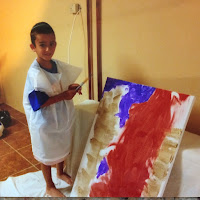The Spanish artist Pablo Picasso once said, "All children are artists. The problem is how to remain an artist once he grows up."
Art is a form of self-expression, one of many modes we can use to communicate our thoughts and emotions. Through art, young children express themselves fearlessly, without inhibitions. They are not self-conscious about their work as they paint or draw. For them, the joy is in the process, with little, if any, forethought to the outcome. Unfortunately, as we grow older, most of us lose the capacity to engage solely in the process. Adults are more concerned with the product: what should this look like when it's finished?; what does it represent? Perhaps that's why the first question many adults ask a child about her art is, "What is it?". More often than not, it's nothing. It's the movement of her hand in response to how she felt at the moment.
It's unfortunate that we lose that innocence in expressing ourselves. As we grow up and come to understand the nuances of how we fit in the world we become more fearful of being hurt, judged or criticized. And unfortunately, most of the time, we are our own worst critics. Many adults also lose their artistic abilities simply because we no longer employ them. I make the same stick figures, houses, and trees as I did as a five year old, because that's when I stopped drawing. Developmentally, my artistic skills are stuck at that level. I think that applies to lots of people.
Art is of course one of many forms of self-expression. Loris Malaguzzi, a founder of the world famous early childhood schools in Reggio Emilia, Italy, coined the phrase, "the hundred languages of children". Everyone wants to be heard, to connect, to make a place for our inner selves in the outer world. And that is best accomplished through the creative arts. Music, painting, sculpture, drama, photography, dance, poetry, etc., etc., give us the means to express our thoughts, dreams, understandings, and imaginations. Literally in a hundred ways. In my opinion, this universal desire to reach beyond the confines of the material world is proof of the soul within us.
Treasure the art that your child creates. If he shows you a painting, talk about the colors, shapes, brush strokes. Let him see the value in the process of creation, without the need to define a finished product. Be honest. Only say it's beautiful if you really think it is. Instead you might praise the effort; "You must have worked hard on this. I see you covered all the white on the paper". If she does make an attempt at representational art, simply ask her to tell you about it. Introduce your child to famous artists and their works, through books and/or a museum visit. Encourage him to notice the details of color, shape, theme, thickness of brush strokes, people, expressions. Think and talk about how the artist communicates to the viewer through these details. "Are the colors dark or light? How do you feel when you look at bright colors?" Engaging with famous works of art in this way will build observation skills and inspire your child to try new techniques in his own work.
We can't all be a Picasso or even a Malaguzzi. But we can give our children time and opportunities to engage in the creative arts, enabling them to find a language for their own inner voice.




No comments:
Post a Comment